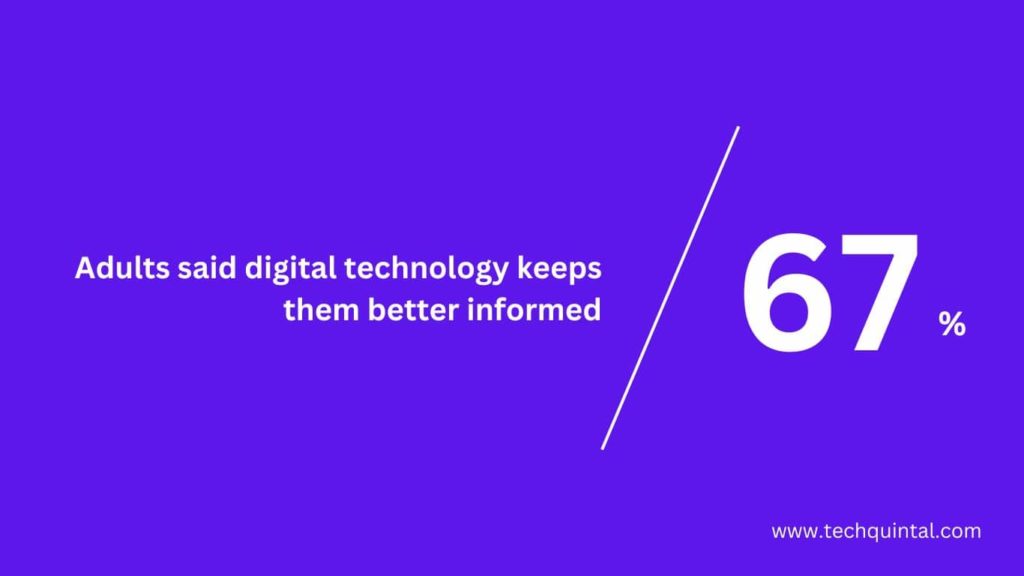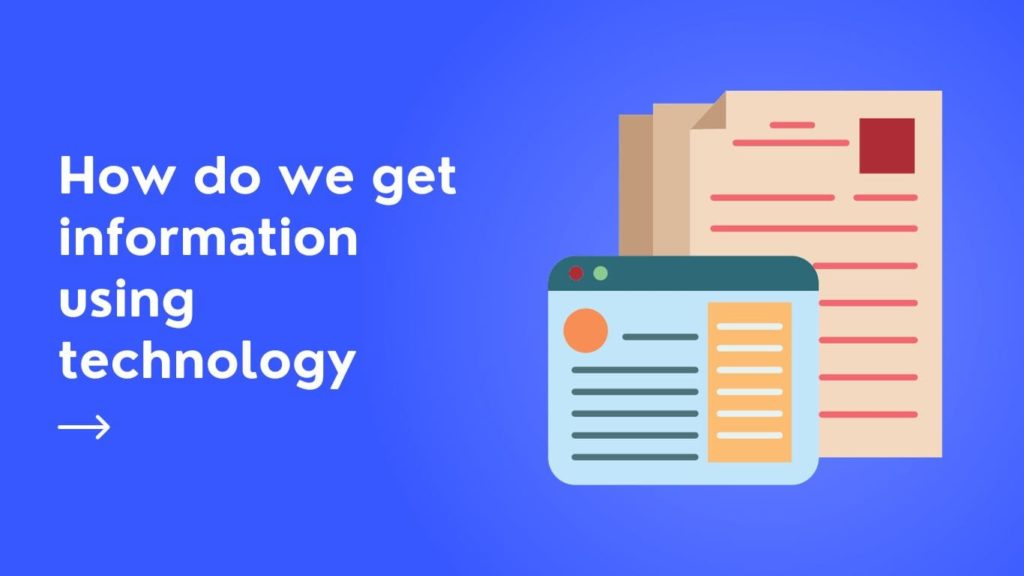
Different types of technology have impacted the world we live in. Among those, information technology has perhaps had the widest area of influence, and the Internet in particular affected the flow of information the most. While the predictions were that it would be overwhelming, the ability to transfer data globally had a positive effect. This change is widely recognized albeit not always directly. To give credence to the entire claim, we’ll use a Pew Research Center survey from December 2014, which analyzed 1066 Internet users, aged 18 and older. So, without further ado, let’s get straight into how technology keeps us informed.
1. Through Products and services
Roughly 81% of American users online stated Internet and smartphone use made them informed about services and products compared to 5 years before (2009). The impact of digital technology on sales can be easily seen from a typical shopping experience.
Users can see the pictures, and read the description and/or specifications. Plus, they get access to independent guides, impressions, and reviews, on the marketplace platform or dedicated websites like Trustpilot or Yelp. Moreover, there are non-profit and for-profit organizations that collect, arrange, and rate information about products, services, or brands.
Finally, users can acquire information from the seller(s) directly. Even better, bots can provide an answer within seconds, or redirect the user to a human representative.
2. Via News
The survey suggests that 75% of Americans think technology provides better knowledge about national news. The number dropped slightly, to 74%, for international news. This is evident once you begin following mainstream news sources.
When put side-by-side, many users discover that the media companies often cite the same source and almost regurgitate the content. This is fine when the source is truthful. However, the existence of the Internet, digital technology, and software lets users get different, even opposing perspectives and opinions. They can then come to conclusions based on multiple sources of information.
3. Popular culture
72% of the surveyed users found technology keeps us informed about popular culture drastically better. Among those, 84% were between the ages of 18 and 29, 77% were aged 30-49, and 68% were aged 50-64. It’s obvious how.
We have social media, file-sharing, streaming apps, website memberships, and digital/online publications. Don’t forget piracy, which has a massive influence on availability to readers, viewers, listeners, or users. Despite evident legal problems, free data or information is known to boost sales positively.
3.1 – Music
If you read Joel Waldoes’s 2019 book Digital Renaissance: What Data and Economics Tell Us About the Future of Popular Culture, you know the number of new songs tripled that year. Additionally, a large portion came from independent record labels. This is due to moving away from traditional marketing, a boom in audio streaming app use, artists’ online presence, and AI-based music recommendations.
3.2 – Books
The number of self-published books on USA Today‘s weekly best-seller list went from 0% years before to 15% in 2019. Also, self-published romance books made up nearly 50% of the genre on the list. Among other reasons, this is due to authors having access to information required for writing, editing, publishing, and marketing online. The sales, once again, came from algorithms for book recommendations.
3.3 – Comic books
Keanu Reeves’ debut comic book, BRZRKR (2021), is one of the highest-ordered first issues by comic shops in the 21st century. The best part? It was published entirely via online crowdfunding and fan campaigns. This level of independent success wasn’t possible a few decades ago, since the information couldn’t reach such a large audience.
4. Friends and family
About 67% of the surveyed adults said digital technology kept them better informed about their friends in 2014 compared to 2009. Similarly, 60% of the adults said they knew more about their family members in 2014 than half a decade ago.

The timeline matches perfectly with social media development. Connecting and exchanging information with people across the globe is also one of the main pros of social media. Things such as messaging apps, video conferencing, and cheap international calls and forums helped too.
Plus, the GPS in smart devices, paired with Google Maps, made obtaining personal information easier. When combined with Yellow Pages/background check websites, we can find personal information with almost nothing to go on.
5. Education
Approximately 87% of participants stated the Internet and smart devices helped them learn new things. Of those, 53% said it boosted this ability “a lot”. What’s more, only 26% felt overloaded with the information they obtained in this way. In contrast, 72% stated they liked having access to such a large flow of information.
This ties in perfectly with the fact that 76% of the participants stated the two technologies made an average American more knowledgeable. Additionally, 77% of them said the same for today’s students. We already went over the effects of technology in education, positive and negative, and examined ways modern technology helps education.
6. Community and government
Only 49% of the adults found that digital technology keeps us better informed about government and civic activities within a community. Well, the number would’ve been much higher today. Both government, business, and non-profit organizations have websites, social media presence, multiple ways of contact, and even bots that answer FAQs.
Civic technology is constantly improving access to data and its transparency. It also affects various data collection, including resident feedback, and assists with public decision-making. On a community level, the efficiency of sharing information via forums, peer-to-peer, or crowdsourcing/crowdfunding platforms, increased significantly in recent years. This improves data organization, the process of electing community representatives, and releasing updates about recent procedures and their status.
7. Natural disasters or emergencies
Remember fires in California and Australia, the Indonesian tsunami, or the Sichuan and Haiti earthquakes? If so, what about how widely and rapidly the information spread globally afterward? And not only that but the repairs that followed?
The quick collection and delivery of funds were possible only due to technological improvements in banking. Transportation technology was responsible for delivering goods and services. We also previously analyzed ways technology keeps us safe and stated researchers are already training AI to predict natural disasters and inform us ahead of time. We even mentioned how algorithms can replace the jobs of journalists, and inform people about an event within mere minutes.
How do we get information using technology?

There are many technological methods to receive and share information, such as:
1. The internet
The Internet has made our lives much easier by allowing us access to a plethora of information with mere clicks. It becomes more apparent when it comes to current events and news. The sheer volume of information you can access online can put every other platform to shame. Today, most people use the internet as their primary source of information. In fact, take America, where over 40 million people rely on the internet for news and information.
2. Smartphones
Then, there are smartphones. They have also become a major source of information. A device that was primarily invented for bidirectional communication has now evolved into something beyond that. There are apps, widgets, subscription services, email, notifications, and so many more features in a smartphone that constantly push information at you, even without you actively pursuing it. Furthermore, these devices even work as platforms for other methods and sources of information.
3. Social Media
We also have social media, which is a premium source of information. These are platforms that offer services such as connectivity, sharing information, videos, personal anecdotes, and so on. But with time, many news organizations have also started migrating to these platforms, making them a valuable source of information. Many users even prefer to get information from such platforms instead of traditional sources.
Here is a table that compares both social and traditional media:
| Features | Social Media | Traditional Media |
|---|---|---|
| Interaction | Very high, allows two-way communication and sharing multimedia | Limited, one-way communication |
| Publication speed | Very fast, in real-time | Slow and methodological |
| Cost | Mostly free | subscription-based model |
| Audience | Global reach | Local, regional, or national audience |
| Trust | Low trust, and can be influenced by misinformation | High trust and credibility |
| Regulations | Loose regulations | Strict regulations and ethics |
| Ownership | Users have ownership of their profile or account | Private ownership |
| Feedback | Detailed feedback in real-time is possible | Limited feedback |
4. News Aggregation
There are also platforms that act as news aggregators. They collect news from multiple sources and curate them at a single location. Furthermore, these platforms allow users to customize or modify their feeds based on their preferences, ensuring they receive relevant information.
5. Podcast and Video Streaming
Podcasts are a series of recordings, or live-streaming, done over the internet with the objective of either inspiring, engaging, or informing the audience. It is a digital program and can be in audio-only or audio-video format.
A podcast contains several episodes that together make a program. It is in a series or episodic format and works as a convenient method of spreading information. We also have streaming platforms and services that cater to movies, documentaries, and entertainment in general.
Podcasts are on the rise, and it is becoming more apparent as many popular platforms have started offering podcast hosting services. Watch what the Wondery CEO Hernan Lopez has to say on the topic:
6. Search Engines
A search engine like Google excels at providing a lot of information to the average user. It is also one of the most used mediums on the internet. Hence, when it comes to finding information on virtually anything, we simply Google it.
Thus, it is apparent that search engines have a huge undertaking in disseminating information. They are not only quick and efficient but also provide multiple sources for the verification of a particular piece of information.
7. Online Learning
Lastly, we have online learning platforms that offer specialized courses and information on particular niches. Although they aren’t suited for the general populace, they still have enough sway when it comes to things like skills or education. Despite offering a particular type of information, they qualify as a competent source, as many users frequent the